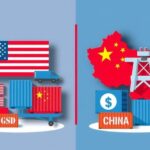Impact of Trump’s Tariffs on China: An Economic Analysis
The U.S. has imposed new tariffs of 54 percent on Chinese imports, escalating trade tensions. This measure threatens China’s export-dependent economy, which constitutes a significant part of its GDP. Beijing is expected to retaliate, creating further complexities in global trade. The impact of these tariffs may extend beyond China, affecting U.S. manufacturers and consumers alike.
The recent implementation of substantial new tariffs by U.S. President Donald Trump on Chinese imports has escalated the ongoing trade conflict between the United States and China. These tariffs, often referred to as “liberation day” tariffs, impose an unprecedented additional levy of 54 percent on Chinese goods, prompting vows of retaliation from Beijing. The ramifications of these tariffs threaten not only China’s economy but also global supply chains and U.S. economic interests.
China’s economy, heavily reliant on exports, faces significant vulnerability due to its intricate ties with international trade dynamics. In 2023, Chinese exports to the United States exceeded $500 billion, representing 16.4 percent of China’s total exports. The imposition of U.S. tariffs could severely impede China’s economic recovery amidst challenges such as a debt crisis in the property sector. Frederic Neumann, Chief Asia Economist at HSBC, indicated that the tariffs could nullify the positive effects of fiscal stimulus intended to bolster economic growth.
The tariffs now impose a 10 percent levy on imports globally, with China experiencing disproportionately high rates. Following the recent implementation, tariffs on Chinese goods have surged to 54 percent after an additional 34 percent on top of an already existing 20 percent. Beijing’s forecast for a five percent GDP growth in 2023 is jeopardized, with analysts estimating an economic impact between 0.5 percent to one percent of GDP. The repercussions primarily threaten key exports from China, including electronics and textiles, exacerbating potential disruptions to U.S. manufacturers as well.
Beijing is contemplating its response to these tariffs, though specific measures have not yet been unveiled. Potentially, China may adjust existing tariffs in retaliation against U.S. imports, maintaining the balance required to avoid a complete economic decoupling. Mei Xinyu, an economist affiliated with the Chinese Academy of International Trade and Economic Cooperation, articulated that China’s countermeasures should strike a balance between being decisive and measured, aiming for effectiveness without exacerbating tensions.
China’s previous tariffs on U.S. imports included a 15 percent levy on coal and liquefied natural gas, targeting specific industries that are crucial to Trump’s voter base. While Beijing expresses a willingness to engage in dialogue to resolve the trade dispute, analysts suggest that reaching a resolution could take considerable time, as historically, tariff increases occur swiftly while decreases are often slow.
The imposition of significant tariffs by the United States on Chinese imports has amplified the trade war between the two largest economies in the world. China’s vulnerability due to its export-driven economy, coupled with the anticipated negative effects on its GDP, underscores the complexities involved. As Beijing prepares potential countermeasures, analysts maintain that any resolution will require considerable negotiation amidst a backdrop of historical precedent favoring the rapid escalation of tariffs over their reduction.
Original Source: www.blackbeltnewsnetwork.com








Post Comment